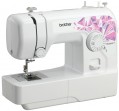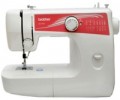Shuttle
The type of sewing machine shuttle.
The shuttle is a device for feeding the lower thread. It is in it that the spool with the thread is inserted. In modern machines there are such types of shuttles:
—
Oscillating . Oscillating shuttles have only a vertical layout. It is a simple, inexpensive and at the same time reliable mechanism, which also makes the device practically “omnivorous”: many models with oscillating shuttles can cope with thick coarse fabrics that are “too tough” for other types of machines. In addition, in such a shuttle, the method of thread tension is very simply regulated. Among the disadvantages of this option, it is worth noting an increased level of vibration and noise, a relatively low speed, as well as a more complicated threading procedure than in horizontal shuttles.
—
Vertical rotary. In several features, such shuttles are similar to oscillating ones (see the relevant paragraph): in particular, they are relatively easy to adjust the thread tension, but to refill the bobbin, you must always climb into the mechanism and remove the bobbin case from the shuttle. The key difference is that the shuttle does not swing during operation, but rotates. Because of this, such mechanisms are somewhat more complicated and more expensive than oscillating ones. However, they provide a higher sewing speed with a lower level of vibration and noise. This option is used
...in professional and semi-professional machines, as well as industrial equipment.
— Horizontal rotary. The shuttle of this type is easy to use: to thread the lower thread, one does not need to remove the bobbin case, just open the cover and install the bobbin directly into the hook. In addition, the top cover is often made transparent, which allows you to keep track of the rest of the bottom thread. At the same time, due to the rotational principle of operation, such a shuttle provides good speed and a minimum level of vibration and noise. Among the disadvantages of this option, one can note the difficulty in setting the thread tension: for this, usually, you have to unscrew a few bolts and remove the entire shuttle(whereas in vertical mechanisms the regulator is located on a quickly removed bobbin head). In addition, horizontal shuttles are not well suited for continuous sewing with coarse threads — such a thread can rub a groove in the case, after which the mechanism will have to be changed.Number of stitches
The number of stitches that a sewing machine can sew. The larger this number, the more extensive the capabilities of this model, the wider the choice the user has; however, it wouldn’t hurt to clarify the specific range of supported stitches separately.
The fewest options - mostly up to 25 - are provided in electromechanical machines, as well as specialized devices such as overlockers and carpet lockers (see “Type”). In computer-controlled devices, the number of lines can be in the dozens, and some also allow you to download additional options from the computer.
Sewing speed
The maximum sewing speed provided by the sewing machine. In the vast majority of models, this parameter can be adjusted, so that, if necessary, you can sew at a lower speed.
The more stitches per minute the machine makes, the higher its productivity, and the better it is suitable for large volumes of work. At the same time, note that high speed has a corresponding effect on price and power consumption, and it is not always required. Detailed recommendations on choosing the optimal speed for certain types of work can be found in special sources.
Presser foots
Types of presser feet supplied with the sewing machine.
— Universal foot. A foot is used for standard sewing, mainly straight stitches and zigzags.
—
Overlock foot. A foot designed for overlocking. By definition, it is found in devices with an overlock function (see “Type”). However, it can also be provided in traditional sewing machines. In the latter case, such a foot, of course, will not replace a full-fledged overlocker, but in some situations it allows you to work without it.
—
Top feed or walking foot. An additional top-mounted feed dog in place of the stock foot, in addition to the standard bottom feed dog. Such a device makes it easier to work with thin, delicate and sliding fabrics, as well as sewing together several layers of fabric: the material moves as evenly as possible, without distortions and displacements.
—
Zipper foot. The foot for sewing in a zipper can have a different size and design — in particular, there are special devices for sewing in a hidden zipper. The specific features of this device should be clarified separately.
—
Decorative stitch foot. Feet designed for various types of decorative stitching. Such a line may not have a functional role. Its main task is to emphasize a certain element of clothing (edges, pockets, individual seams, etc.). Anyway, the stit
...ch line should usually strictly follow the contour along which it is applied — and this contour can consist of both straight lines and curved lines. Special feet for decorative stitching simplify the task: they are equipped with rulers or other devices that allow you to control the parallelism of the stitches.
— Satin stitch foot. This foot will be suitable for appliqué and other work where zigzag stitches are often used.
— Blind hem foot. Foot designed for blind seams used when hemming the edge of the fabric. It is equipped with a device that provides a hem of the fabric and in this position feeds it under the needle.
— Quilting foot. Special feet for quilting — patchwork. In such works, it is necessary to sew the fabric in several layers, as well as to perform figured seams. In extreme cases, you can use the usual universal foot for quilting, but using a special device is still much more convenient.
— Monogramming foot. The foot for embroidery of monograms will allow you to make embroidery on any object, thereby decorating it with your signature or the emblem of any institution, company, or sports club.
— Buttonhole foot. Buttonhole foot. It eliminates the need for manual work. The sewing machine will do everything for you, which will reduce your time and please you with quality.
— Button sewing foot. A foot is designed to hold the button on the fabric while sewing on. It has a special protrusion pointing down: when the main part of the foot is pressed against the button, this protrusion presses the fabric and prevents it from slipping.
In addition to the above, other types of feet may be included in the delivery kit.Led lighting
A built-in lighting system that illuminates the working table of the machine, which is made of LEDs. In addition to the bright illumination of the work area,
LED-light sewing machines also have lower energy consumption compared to classic lamps.
Power consumption
The power consumed by the machine during operation. Usually, the maximum power value is indicated in the characteristics.
Most of the electricity supplied to the machine is consumed by the engine, so this indicator primarily describes the power of the engine. The higher this power, the faster the machine can work and the better it is suitable for working with dense fabrics. However, there is no strict dependence here, much also depends on the general specialization of the unit.

